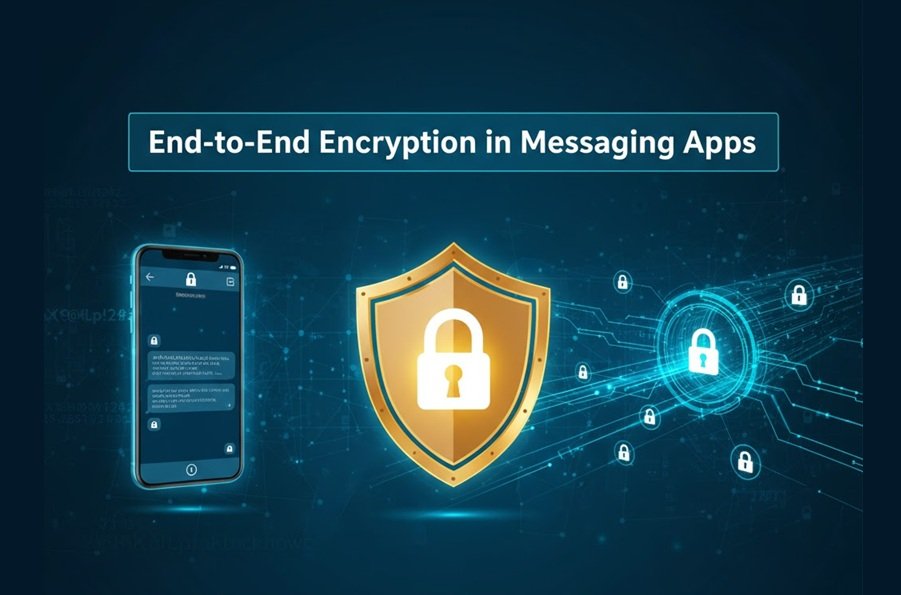
End-to-End Encryption (E2EE) in Messaging Apps — A deep, practical analysis
End-to-end encryption (E2EE) is the technical backbone that gives modern messaging apps their promise of private conversations: only the real participants can read message content. But “E2EE” is not a single switch you flip — it’s a design space filled with architectural choices, trade-offs, and subtle pitfalls. This article explains how E2EE works in messaging apps, why it matters, the main protocols and building blocks, real-world problems (metadata, backups, multi-device), attack surfaces, and practical guidance for product and engineering teams.
1. What exactly does E2EE protect?
At a high level, E2EE ensures that plaintext message content (and sometimes attachments) are only readable by the intended endpoints (sender and recipients). E2EE typically protects:
- Message bodies (text, images, files)
- Voice/video payloads (when those transport channels are encrypted end-to-end)
- Attachments and local search indexes (if encrypted client-side)
What E2EE usually does not fully protect:
- Metadata (who talked to whom, when, message sizes, IP addresses) — unless you build special systems to hide it
- Server-side logs of encrypted blobs (the server can store encrypted data but not read it)
- Backup data if backups are not protected with a client-only key
- Device identifiers and some user profile fields required for discovery
A clear threat model is the essential first step: are you protecting against passive eavesdroppers, malicious servers, state actors, or coerced endpoints? The design choices follow the threat model.
2. Core cryptographic building blocks
Modern E2EE messaging uses a combination of primitives. Briefly:
- Asymmetric key agreement (Diffie-Hellman, e.g., X25519 / Curve25519): establishes shared secrets between parties.
- Signature keys (Ed25519 etc.): authenticate keys and prevent man-in-the-middle attacks during key exchange.
- Symmetric authenticated encryption (AES-GCM, ChaCha20-Poly1305): encrypts message content.
- Key derivation (HKDF): expand/derive keys securely from shared secrets.
- Ratchets (Double Ratchet algorithm): provide forward secrecy and post-compromise security by rotating keys after each message.
- Pre-keys / one-time keys: allow asynchronous message delivery without both parties being online (used in Signal/WhatsApp).
- Group keying schemes: Sender Keys, pairwise mesh, or tree-based protocols (e.g., MLS) for efficient group encryption.
Understanding these parts lets you reason about properties like forward secrecy, message unlinkability, and resistance to key compromise.
3. How one-to-one E2EE typically works (overview)
A typical flow in many modern apps (inspired by Signal) looks like:
- Identity keys: each user has a long-term identity key pair (signing key).
- Pre-keys: clients publish temporary pre-keys to the server so others can start conversations when the recipient is offline.
- Initial handshake: when Alice wants to message Bob, Alice retrieves Bob’s identity key + a pre-key, performs an authenticated key agreement (X3DH-like), verifying Bob’s identity key signature to avoid MITM.
- Shared secret → root key: both sides derive a root secret and initialize the Double Ratchet.
- Per-message ratcheting: each message uses a message key derived from the ratchet; after use, keys are advanced (forward secrecy).
- Acknowledgements / new sessions: if one side is compromised and then recovers, the ratchet limits damage to a window of messages (post-compromise security improves after a few messages).
This provides asynchronous, authenticated E2EE with forward secrecy — good for most use cases.
4. Group messaging: hard problems and solutions
Groups are where E2EE complexity explodes.
Common models:
- Pairwise mesh: encrypt each message individually to each recipient using pairwise sessions. Simple but scales poorly (O(n) encryptions per message) and leaks that same recipient set per message (unless you hide it).
- Sender Key / symmetric group keys: one sender generates a symmetric group key and distributes it encrypted to recipients via pairwise channels. After distribution, the sender encrypts messages once with the group key (efficient). However, membership changes and forward/backward secrecy across joins/leaves need careful handling. WhatsApp historically used a sender-key approach built on Signal’s primitives.
- Tree-based protocols (MLS — Messaging Layer Security): designed to scale to large groups while providing strong security properties (member exclusion, efficient rekeying). MLS uses a cryptographic tree structure so rekeying is O(log n) rather than O(n). MLS is becoming the standard for new group E2EE designs.
Key challenges in groups:
- Efficient rekeying on membership changes (join/leave)
- Forward secrecy vs. message retrievability (if you rekey aggressively, historical messages may become unreadable for new members; if too lax, ex-members can read past messages)
- Handling offline members (must deliver key updates and missed messages)
- Server-assisted features like search, moderation, message deletion — hard to do without exposing plaintext or adding complex client-side processing.
5. Multi-device and synced clients
Users expect messaging to sync across phones, tablets, web clients. Multi-device E2EE introduces complexity because private keys historically lived on a single device.
Approaches:
- Single primary device + linked clients: primary device holds identity keys; additional devices are linked and receive session keys via authenticated channels. Signal and WhatsApp use variants of this.
- Device-independent identity: each device has its own identity key and the server manages a set of devices per user. Clients pick which device(s) to deliver to. This works but increases management complexity.
- Key backup: encrypted backups of identity material (protected by user passphrase) allow recovery but raise the question of where the key is stored and who can decrypt it. Client-side, passphrase-derived keys (PBKDF2/Argon2) are common to protect backups.
Tradeoffs: usability (easy linking/recovery) vs security (storing keys anywhere increases attack surface). UX design must explain tradeoffs to users clearly.
6. Metadata: the often-ignored Achilles’ heel
Even with perfect content encryption, metadata can leak sensitive information: who communicates with whom, group membership changes, timestamps, message sizes, and presence. This data is valuable for profiling or inference attacks.
Mitigations:
- Minimize server logs: store only what is necessary and delete early.
- Use ephemeral identifiers: rotate tokens/identifiers to avoid long-term linkage.
- Private contact discovery: contact discovery without sending your whole address book in plaintext — techniques include hashing with salt, bloom filters, or more advanced private set intersection (PSI) protocols. PSI is computationally heavier but protects address book privacy.
- Mixing / cover traffic: add dummy traffic to obscure patterns (expensive and rarely used in consumer apps).
- Metadata-minimizing architectures: e.g., peer-to-peer overlays where possible, but they have availability and NAT traversal problems.
Complete metadata protection is extremely hard and often impractical for mainstream apps, but privacy-minded apps should reduce metadata surface aggressively.
7. Backups, search, and server-side features
Features like cloud backups and server-side search are challenging when you don’t want servers to read messages.
Options:
- Client-side encrypted backups: backup is encrypted with a user-held key (e.g., passphrase). Recommended for privacy, but users must manage keys or accept the risk of permanent loss.
- Encrypted search: searchable encryption schemes exist (deterministic encryption, searchable symmetric encryption) but leak patterns and require careful design. Another approach: perform search client-side by downloading encrypted index and decrypting locally.
- Server-side features (spam filtering, moderation): require plaintext access. Alternatives include client-side moderation (burdensome), or exposing limited metadata to trusted services under clear policies.
Product teams must decide which server-side features they want and whether they accept the tradeoff of decrypting data for those features.
8. Common attack vectors and mitigations
- Key compromise on client devices: mitigate by using secure enclaves, strong OS-level protections, and encouraging device passcodes.
- Social engineering & phishing: strong authentication of device linking, key verification (safety numbers / QR codes) helps. But users rarely verify; app designs must make verification simple and recommended.
- Malicious server: protect by minimizing server trust (store minimal metadata), sign messages with user keys, and use public key transparency if appropriate.
- Backup/key escrow abuse: avoid server-side escrow; if backup is offered, use user-controlled keys or transparently explain tradeoffs.
- Traffic analysis: mitigate by batching, adding jitter, or cover traffic where feasible.
9. UX and product considerations
Security is useless if users don’t adopt it. Important UX lessons:
- Make E2EE the default — users shouldn’t need to opt in for privacy.
- Make key verification easy — QR codes or short authentication strings, and surface verification during linking.
- Explain tradeoffs transparently — e.g., “Cloud backup will save your chat history but can be decrypted with X.”
- Graceful multi-device flows — linking should be secure but not cryptic.
- Handling lost devices — provide clear recovery flows or irreversible account resets, with explicit warnings.
10. Regulatory, legal, and operational issues
E2EE can conflict with law-enforcement demands in some jurisdictions. Companies must navigate:
- Legal obligations: some governments may demand access or compel providers to implement backdoors. Many privacy-conscious vendors resist backdoors due to security risks.
- Transparency & documentation: clear legal policies, Transparency Reports, and data access request procedures build trust.
- Geopolitical data residency: E2EE reduces the value of server location for content security, but metadata and infrastructure still matter for regulatory compliance.
Design with legal counsel and a clear public stance on user privacy.
11. Emerging standards and the future
Key directions:
- MLS (Messaging Layer Security): standardizing secure, scalable group messaging — expect adoption across apps that need large groups and strong properties.
- Better client-side search & usability: advances in searchable encryption and secure enclaves will make private, featureful apps more usable.
- Interoperability: federated E2EE (different apps talking securely) is nascent; standards could enable cross-platform encrypted messaging, but adoption requires political and technical work.
- Post-quantum considerations: planning for quantum-resistant key exchange will matter in high-security contexts; hybrid schemes may be used in the medium term.
12. Practical engineering checklist (short)
If you’re building E2EE into a messaging app, start here:
- Define a clear threat model and regulatory constraints.
- Use proven protocols (Signal Protocol, MLS) rather than rolling your own crypto.
- Implement authenticated key exchange + signature verification.
- Provide forward secrecy and post-compromise recovery (ratchets).
- Design secure device-linking and key backup flows (client-controlled encryption).
- Minimize and protect metadata (privacy-aware discovery, short retention).
- Plan for group messaging with an MLS or sender-key approach depending on scale.
- Harden clients (secure storage, secure enclaves, regular security audits).
- Test with red teams, threat model reviews, and cryptography reviews.
- Communicate clearly to users: defaults, backups, and recovery tradeoffs.
13. Conclusion
E2EE is a powerful tool for protecting user privacy, but it’s not binary — it’s a collection of techniques, trade-offs, and user experience choices. Good E2EE provides strong content confidentiality, forward secrecy, and authenticated communication while recognizing practical constraints like metadata leakage, multi-device usability, and backup requirements. For product teams, the right outcome balances security, transparency, and practical features so users get private, reliable, and usable messaging.
If you want, I can:
- produce a technical design doc for implementing Signal-style E2EE step-by-step;
- draft a developer checklist for MLS adoption for groups; or
- write a UX flows doc for secure device linking and key backup — tell me which and I’ll produce it now.
Suggested Articles
- Zoho Show vs Microsoft PowerPoint: The Complete Comparison for 2025
- Zoho Sheets vs Microsoft Excel: A Detailed Comparison for 2025
- Zoho Writer vs MS Word: A Comprehensive Comparison for 2025
- Zoho Office Suite vs Microsoft Office: A Complete Comparison
- Arattai vs WhatsApp: A Detailed Comparison of Messaging Apps
- Zoho Mail vs Google Mail (Gmail): Detailed Comparison for 2025
- Aadi Vaani: India’s AI-Powered Platform to Preserve Tribal Languages






